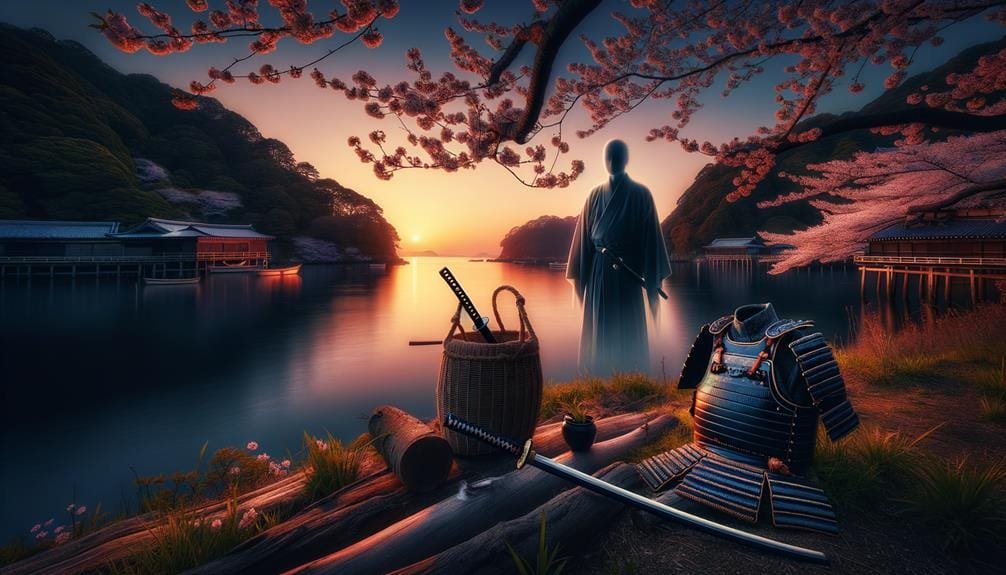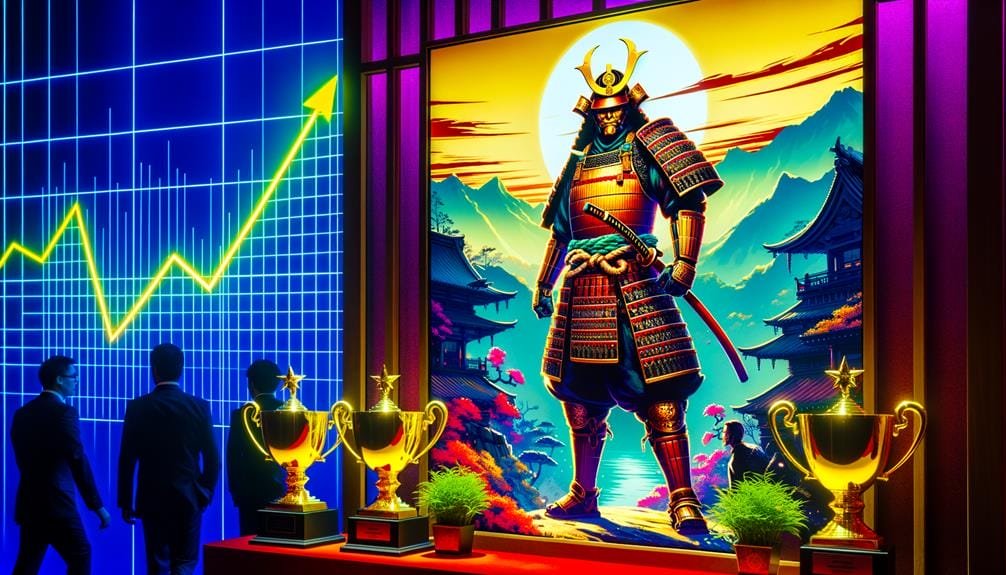Our Newsletter
Sign up for our e-mail newsletter and stay informed for what’s next on the horizon.
As we journey across the wind-battered plains and lush bamboo forests of Tsushima Island, we become more than just players – we transform into samurai warriors, experiencing Jin Sakai’s compelling tale in ‘Ghost of Tsushima’.
The game masterfully balances stealth and combat, blending it with a captivating storyline and breathtaking visuals, making for a gameplay experience that’s hard to rival.
But, does the meticulous historical accuracy and portrayal of feudal Japan elevate or diminish your gameplay? And how about the ethical decisions you make – do they genuinely influence the game’s direction?
Let’s untangle these queries together.
‘Ghost of Tsushima’ has proven to be an extraordinary blend of historical accuracy, engaging story, and enthralling gameplay. Its impressive sales figures, exceeding 5 million units in only a few months, attest to its worldwide appeal.
This samurai epic does more than merely entertain; it educates players about feudal Japan, setting it apart within the domain of action-adventure games. It’s a game that any enthusiast would regret not exploring.
In ‘Ghost of Tsushima’, gameplay mechanics are deftly designed to boost player involvement, with combat stances designed for various enemy types being a primary feature. As samurai, we’re granted the ability to toggle between these stances, bestowing a degree of strategic gameplay that keeps us absorbed and challenged.
The ghost stance, introduced as an upgrade, provides temporary invulnerability, broadening the dynamic combat choices. We’re not just confined to conventional samurai weapons; we can also employ a range of ghost weapons. These instruments diversify our strategies and entry to battles, catering to our preference for liberty in gameplay.
Significantly, managing our resolve is vital. It’s not just about health preservation; mastering combat techniques in the game also relies on this system. We’re urged to strike a balance between aggression and caution, making each combat encounter a thrilling strategic decision.
The stagger system adds to the combat experience. It disrupts enemy defenses, introducing depth and complexity to the combat system. It’s an affirmation of the game’s dedication to deliver a genuine and engaging samurai adventure on the island of Tsushima.
Transitioning from the game’s complex mechanics, let’s now focus on the fascinating narrative and intricate characters that form the core of ‘Ghost of Tsushima’. At the narrative’s heart is Jin Sakai, a samurai grappling with the strictness of his honor and the need for irregular strategies in his pursuit of vengeance and justice.
The narrative delves into the psychological impact of war through Jin’s encounters with his allies, each carrying their own distinct tale of pain and loss. They are not just supporting characters but detailed individuals, each burdened with their own distinct tale of pain and loss.
Here’s a breakdown:
| Character | Conflict |
|---|---|
| Jin Sakai | Honor vs. Necessity |
| Allies | Loss vs. Survival |
The narrative sharply juxtaposes these deeply personal conflicts against the broader war’s backdrop, creating an atmosphere that is both personal and vast. The fight scenes also mirror the narrative’s complexity, striking a balance between hand-to-hand combat and strategic infiltration.

Stepping into the world of ‘Ghost of Tsushima’s’ setting and artistic design, we’re met with an amplified, picturesque depiction of feudal Japan that mesmerizes with its striking visuals. Sucker Punch Productions has expertly captured the melancholic mood of the game environment by interlacing nature’s allure with the artistic display, thereby offering a sense of relief amid intense combat.
The game’s appealing aspects extend beyond its visuals. The unique haiku crafting mechanic is a novel addition that boosts player involvement, fostering a sense of liberation and creativity within the organized gameplay. This mechanic, combined with regular visits to peaceful Inari shrines, fortifies the game’s potent cultural identity.
The outstanding weather effects contribute an extra layer of depth, emphasizing the game’s artistic direction. Kurosawa mode, specifically, pays tribute to the respected filmmaker, showcasing the game in a stark black-and-white style that complements the game’s feudal Japan setting.
Examining ‘Ghost of Tsushima’s’ engaging soundtrack and audio elements, we find a renowned score that merges traditional Japanese instruments with grand orchestral compositions, offering a dense auditory experience. This samurai saga, crafted by Sucker Punch, employs sound to transport participants to the Island of Tsushima, immersing them in an atmospheric world that feels tangible and vibrant.
What makes the game stand out, is the meticulous attention to detail in the audio elements. Here’s a summary of what’s noteworthy:
In ‘Ghost of Tsushima’, Sucker Punch has crafted not just a game, but an auditory journey through a finely detailed samurai saga.

In the area of sales performance, Ghost of Tsushima has made a substantial impact, selling over 9.73 million copies since its 2020 launch. This action-adventure game, rich in martial arts elements, has fascinated audiences with its intriguing side quests, multifaceted characters, and dynamic narrative. The robust sales figures speak volumes about the game’s quality and the autonomy it provides to players.
In addition to its commercial performance, Ghost of Tsushima has received high praise from critics and players. The combat, story, and musical score are all lauded, contributing to its standing as a well-executed samurai saga. This acclaim hasn’t gone unnoticed, with the game being shortlisted for a slew of awards in acknowledgment of its accomplishments.
In addition, the game’s success has kindled interest in other forms of media. A movie version is currently being produced, aiming to extend the reach of the game’s story to a broader audience. The positive reviews and awards are testament to the game’s quality, and the anticipation for the movie version emphasizes its influence even more.
In response to the query, ‘Is Jin Sakai a real person?’ the answer is no. He is a character of imagination, designed specifically for the game. His identity as a samurai warrior is not based on any actual persons from the annals of Japanese history.
It’s not clear-cut to claim that Sekiro outperforms Ghost of Tsushima. This is a matter of individual taste. The detailed combat system of Sekiro attracts some players, while others are drawn to the combat styles and adventure found in Ghost. It all comes down to what one personally enjoys.
Jin Sakai is considered a traitor due to his refusal to adhere to samurai customs, choosing instead to employ unconventional tactics against his adversaries. His actions, which are seen as treasonous, are driven by desperate conditions, demonstrating his willingness to abandon tradition for the sake of Tsushima’s preservation.
Determining an exact figure for samurai casualties in Ghost of Tsushima is challenging as it relies on the decisions and actions of each individual player. The cruel ballet of warfare takes a heavy toll, mirroring the severe circumstances samurai encountered during battles.
‘Ghost of Tsushima’ has proven to be an exceptional fusion of historical precision, enveloping narrative, and captivating gameplay. Its remarkable sales numbers, surpassing 5 million units within just a handful of months, demonstrate its global popularity.
This samurai tale does more than just amuse; it informs players about feudal Japan, marking it as distinct within the sphere of action-adventure games. It’s a game that any enthusiast would be remiss not to experience.We really hope you enjoyed one of our Video Game Reviews!
Sign up for our e-mail newsletter and stay informed for what’s next on the horizon.